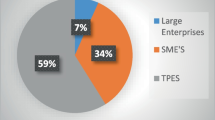Abstract
We examine the determinants of performance of 68 Indian state-owned enterprises in the manufacturing sector for a five-year period: 1987 to 1991. Relative performance is determined using data envelopment analysis, with variations in performance patterns subsequently explained using regression analysis. We note that the performance of firms in the Indian state-owned sector is characterized by both, low performance, as well as significant and systematic variations in the performance parameters. Size is positively associated and age negatively associated with efficiency. Further, economic liberalization and reforms aimed at improving the performance of state-owned firms induces efficiency gains over time. This heterogeneity within the state-owned sector has policy implications, which we discuss. In countries which have privatized large numbers of their state-owned firms, it is often the larger establishments which have been sold to the public. The state-owned firms in the manufacturing sector that can be candidates for privatization are the smaller and older manufacturing firms. These firms may also be easier to dispose of to private investors. This finding reinforces our central thesis that firm-level analysis within the state-owned sector is useful and important for generating pragmatic policy guidelines.
Similar content being viewed by others
References
Aharoni, Y. (1981). “Performance Evaluation of State Owned Enterprise: A Process Perspective.” Management Science 27(11), 1340–1347.
Ahluwalia, I. J. (1991). Productivity and Growth in Indian Manufacturing. New Delhi: Oxford University Press.
Banker, R. D., A. Charnes, and W. W. Cooper, (1984). “Some Models for Estimating Technical and Scale Efficiencies in Data Envelopment Analysis.” Management Science 30(9), 1078–1092.
Bhagwati, J. N. (1993). India in Transition: Freeing the Economy. Oxford: Clarendon Press.
Bhargava, A., L. Franzini, and W. Narendranathan. (1982). “Serial Correlation and the Fixed Effects Model.” Review of Economic Studies, 533–549.
Bhaya, H. (1990). “Management Efficiency in the Private and Public Sectors in India.” In J. Heath (ed.), Public Enterprise at the Crossroads. London: Routledge.
Boardman, A. E., and A. R. Vining. (1989). “Ownership and Performance in Competitive Environments: A Comparison of the Performance of Private, Mixed, and State-Owned Enterprises.” Journal of Law and Economics 32, 1–33.
Bruno, M. (1978). “Duality, Intermediate Inputs and Value Added.” In M. Fuss and D. McFadden, (eds.), Production Economics: A Dual Approach to Theory and Applications. Amsterdam: North-Holland.
Capon, N., J. V. Farley, and S. Hoenig. (1990). “Determinants of Financial Performance: A Meta-Analysis.” Management Science 36, 1169–1177.
Caves, R. E. (1992). Industrial Efficiency in Six Nations. Cambridge, MA: The MIT Press.
Charnes, A., W. W. Cooper, and E. Rhodes. (1978). “Measuring the Efficiency of Decision Making Units.” European Journal of Operations Research 2(6), 429–444.
Charnes, A., W. W. Cooper, and E. Rhodes. (1981). “Program Evaluation and Managerial Efficiency: An Application of Data Envelopment Analysis to Program Follow Through.” Management Science 27, 668–697.
Denison, E. F. (1974). Accounting for United States Economic Growth: 1929 to 1969. Washington, D.C.: The Brookings Institution.
Diewert, W. E. (1978). “Hicks' Aggregation Theorem and the Existence of a Real Value Added Function.” In M. Fuss and D. McFadden, (eds.), Production Economics: A Dual Approach to Theory and Applications.Amsterdam: North-Holland.
Downs, A. (1967). Inside Bureaucracy. Boston: Little, Brown & Co.
Farrell, M. J. (1957). “The Measurement of Productive Efficiency.” Journal of the Royal Statistical Society Series A (General) 120(3), 253–281.
Golany, B., and Y. Roll. (1993). “Some Extensions of Techniques to Handle Non-Discretionary Factors in Data Envelopment Analysis.” Journal of Productivity Analysis 4, 419–432.
Griliches, Z., and V. Ringstad. (1971). Economies of Scale and the Form of the Production Function. Amsterdam: North-Holland.
Hannan, M., and J. Freeman. (1989). Organizational Ecology. Cambridge, MA: Harvard University Press.
Jackson, P. M., and A. J. Palmer. (1988). “The Economics of Internal Organization: The Efficiency of Parastatals in Less Developed Countries.” In P. Cook and C. Kirkpatrick (eds.), Privatization in Less Developed Countries. New York: St. Martin's Press.
Jalan, B. (1991). India's Economic Crisis: The Way Ahead. New Delhi: Oxford University Press.
Jones, L. P. (1991). “Performance Evaluation for State Owned Enterprise. In R. Ramamurti and R. Vernon (eds.), Privatization and Control of State Owned Enterprise. 179–205. Washington D.C.: The World Bank.
Joshi, V., and I. M. D. Little. (1994). India: Macroeconomics and Political Economy, 1964–1991. New York: Oxford University Press.
Khandwalla, P. N. (1990). Excellent Management in the Public Sector. New Delhi, India: Vision Books Pvt. Ltd.
Kmenta, J. (1986). Elements of Econometrics. New York: Macmillan.
Lawrence, P. R., and D. Dyer. (1983). Renewing American Industry. New York: Free Press.
Lioukas, S., D. Bourantas, and V. Papadakis. (1993). “Managerial Autonomy of State Owned Enterprise: Determining Factors.” Organization Science 4, 645–666.
Majumdar, S. K. (1995). “X-Efficiency in Emerging Competitive Markets: The Case of U. S. Telecommunications.” Journal of Economic Behavior and Organization 26(1), 129–144.
Marathe, S. S. (1989). Regulation and Development. New Delhi: Sage Publications.
Mazumdar, D. (1983). “Segmented Labor Markets in Less Developed Countries.” American Economic Review 73, 254–259.
Mazumdar, D. (1991). “Import Substituting Industrialization and Protection of the Small Scale: The Indian Experience in the Textile Industry.” World Development 19, 1197–1213.
Millward, R. (1988). “Measured Sources of Inefficiency in the Performance of Private and Public Enterprise in the Less Developed Countries.” In P. Cook and C. Kirkpatrick (eds.), Privatization in Less Developed Countries. New York: St. Martin's Press.
Nayar, B. R. (1990). The Political Economy of India's Public Sector. Bombay: Popular Prakashan Private Limited.
Nelson, R. R. (1991). “Research on Productivity Growth and Productivity Differences: Dead Ends and New Departures.” Journal of Economic Literature 19, 1029–1064.
Newbery, D. M. (1992). “The Role of Public Enterprises in the National Economy.” Asian Development Review, 1–34.
Powell, W. W., and P. J. DiMaggio. (1991). The New Institutionalism in Organizational Analysis. New York: Cambridge University Press.
Prescott, E. C., and R. Vischer. (1980). “Organization Capital.” Journal of Political Economy 88, 446–461.
Ramamurti, R. (1987). “Performance Evaluation in State-Owned Enterprises in Theory and Practice.” Management Science 33, 876–893.
Reddy, Y. V. (1990). “Liberalization and Privatization of Public Enterprise in India.” In J. Heath (ed.), Public Enterprise at the Crossroads. London: Routledge.
Scherer, F. M., and D. Ross. (1990). Industrial Market Structure and Economic Performance. Chicago: Rand McNally.
Seiford, L. M., and R. M. Thrall. (1990). “Recent Developments in DEA: The Mathematical Programming Approach to Frontier Analysis.” Journal of Econometrics 46, 7–38.
Smyth, P. (1990). “Data Envelopment Analysis Applied to Financial Statements.” Omega 18(2), 131–138.
Smyth, P., and D. Mayston. (1986). “Measuring Efficiency in the Public Sector.” Omega 15(3), 181–189.
Thore, S., G. Kozmetsky and F. Phillips. (1994). “DEA of Financial Statements Data: The U. S. Computer Industry.” Journal of Productivity Analysis 5, 229–248.
Tirole, J. (1988). The Theory of Industrial Organization. Cambridge, MA: MIT Press.
Trivedi, P. (1992). A Critique of Public Enterprise Policy. New Delhi: International Management Publishers.
Tulkens, H. (1992). “Economics and the Performance of the Public Sector.” Annals of Public and Cooperative Economics 63(3), 373–385.
Author information
Authors and Affiliations
Rights and permissions
About this article
Cite this article
Ahuja, G., Majumdar, S.K. An Assessment of the Performance of Indian State-Owned Enterprises. Journal of Productivity Analysis 9, 113–132 (1998). https://doi.org/10.1023/A:1018352415813
Issue Date:
DOI: https://doi.org/10.1023/A:1018352415813




